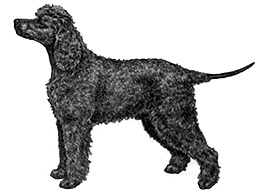Irish Water Spaniel Breed Standard
Last updated: 03 Aug 2008
A breed standard is the guideline which describes the ideal characteristics, temperament, and appearance of a breed and ensures that the breed is fit for function with soundness essential. Breeders and judges should at all times be mindful of features which could be detrimental in any way to the health, welfare or soundness of this breed.

Kennel Club, London 1994
-
Group:
Group 3 (Gundogs)
-
History:
-
General Appearance:
Smart, upstanding, strongly built, compact.
-
Characteristics:
Enduring, versatile gundog for all types of shooting particularly in wildfowling.
-
Temperament:
Initially aloof, staunch and affectionate; with an endearing sense of humour and a stable disposition.
-
Head And Skull:
Head of good size. Skull high in dome; of good length and width allowing adequate brain capacity. Muzzle long, strong, somewhat square with gradual stop. Face smooth, nose large and well developed, dark liver colour, overall an impression of fineness.
-
Eyes:
Comparatively small, almond shaped, medium to dark brown, intelligent and alert.
-
Ears:
Long oval-shaped; set low, hanging close to cheeks.
-
Mouth:
Jaws strong with a perfect, regular and complete scissor bite, i.e. Upper teeth closely overlapping lower teeth and set square to the jaws.
-
Neck:
Strongly set into shoulders, powerful, arching and long enough to carry the head well above level of back.
-
Forequarters:
Shoulders powerful and sloping; chest deep, reasonable width and curvature between forelegs. Forelegs well boned and straight.
-
Body:
Ribs carried well back, so well sprung behind shoulder as to give a barrel-shape. Back short, broad, and level, strongly coupled to hindquarters. Loins deep and wide.
-
Hindquarters:
Powerful; well angulated stifle and low set hock.
-
Feet:
Large round and spreading, well covered with hair over and between toes.
-
Tail:
Short, not reaching to hock joint, straight, thick at root and tapering to a fine point. Low set, straight and below level of back. Three to four inches of tail root covered by close curls which stop abruptly. The remainder bare or covered by short straight, fine hairs.
-
Gait/Movement:
Moves freely and soundly, with reach and drive; characteristic rolling motion accentuated by barrel-shaped rib cage.
-
Coat:
On body, dense, tight, crisp ringlets, free from woolliness. Hair having natural oiliness. Forelegs covered down to feet with curls or ringlets. Abundant all round, though shorter in front. Below hocks, hindlegs should be smooth in front and with curls or ringlets behind down to feet. On skull covering of long curls forming a pronounced top-knot, growing in a well defined peak to a point between the eyes. Ears covered with long twisted curls. Neck covered with curls similar to those on body. Throat smooth, the smooth hair forming a 'V' shaped patch from back of lower jaw to breast bone.
-
Colour:
Rich dark liver with purplish tint or bloom peculiar to the breed and sometimes referred to as puce-liver.
-
Sizes:
Height: Dogs 53-58 cms (21-23 ins)
Bitches 51-56 cms (20-22 ins)
-
Faults:
Any departure from the foregoing points should be considered a fault and the seriousness with which the fault should be regarded should be in exact proportion to its degree and its effect upon the health and welfare of the dog, and on the dog’s ability to perform its traditional work.
-
Notes:
Male animals should have two apparently normal testicles fully descended into the scrotum.
 For owners
For owners
 Members
Members
 Dogs Australia is a not-for-profit organisation advocating for the preservation of purebred dogs through ethical breeding.
It champions the highest standard of animal welfare through education and fostering dog-loving communities.
Internationally recognised and established in 1958 as the Australian National Kennel Council (ANKC),
the organisation promotes responsible dog ownership; maintains the ORCHID* heritable canine diseases database;
funds research into canine diseases; and supports state and territory-based member bodies.
Dogs Australia promotes breed conformation shows and community sports for dogs that fulfil a breed’s natural instincts.
Dogs Australia is a not-for-profit organisation advocating for the preservation of purebred dogs through ethical breeding.
It champions the highest standard of animal welfare through education and fostering dog-loving communities.
Internationally recognised and established in 1958 as the Australian National Kennel Council (ANKC),
the organisation promotes responsible dog ownership; maintains the ORCHID* heritable canine diseases database;
funds research into canine diseases; and supports state and territory-based member bodies.
Dogs Australia promotes breed conformation shows and community sports for dogs that fulfil a breed’s natural instincts.







